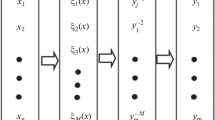Abstract
This paper proposes a force control strategy for robotic manipulators considering a non-rigid environment described by a nonlinear model. This approach uses a fuzzy predictive algorithm to generate, in an optimal way, the reference or virtual position to the classical impedance controller in order to apply a desired force profile on the environment. The main advantage of this control strategy is the possibility of including a nonlinear model of the environment in the controller design in a straightforward way, improving the global force control performance, especially in non-rigid environments. Moreover, in order to reduce the oscillations on the optimized reference position a fuzzy scaling machine is included on the force control strategy. The performance of the force control scheme is illustrated for a two degree-of-freedom PUMA 560 robot, which end-effector is forced to move along a flat surface located on the vertical plane. The simulation results obtained with the fuzzy control scheme reveal significant improvement in the force tracking performance, when compared to the impedance control with force tracking in non-rigid environments.
Similar content being viewed by others
References
Baptista, L. F., Botto, M. A., and Sá da Costa, J. M.: A predictive force control approach of robotic manipulators in non-rigid environments, Internat. J. Robotics Automation 15(2) (2000), 19-24.
Baptista, L. F., Botto, M. A., and Sá da Costa, J. M.: Force control of rigid manipulators: A comparative study for non-rigid environments, in: Proc. of the IEEE Internat. Symposium on Industrial Electronics, Guimarães, Portugal, July 1997, Vol. 3, pp. 878-888.
Camacho, E. F. and Bordons, C.: Model Predictive Control in the Process Industry, Springer, London, 1995.
Corbet, T., Sepehri, N., and Lawrence, P. D.: Fuzzy control of a class of hydraulically actuated industrial robots, IEEE Trans. Control Systems Technology 4(4) (1996), 419-426.
De Schutter, J., Bruyninckx, H., and Spong, M.: Force control: A bird's eye, in: Proc. of IEEE CSS/RAS Internat. Workshop on Control Problems in Robotics and Automation: Future Directions, San Diego, USA, December 1997.
de Witt, C. C., Siciliano, B., and Bastin, G.: Theory of Robot Control, Communications and Control Engineering, Springer, UK, 1997.
Economou, C., Morari, M., and Palsson, B.: Internal model control. 5. Extension to nonlinear systems, Ind. Engrg. Chem. Process Des. Dev. 25(1986), 403-411.
Fukuda, T. and Kubota, N.: An intelligent robotic system based on a fuzzy approach, Proc. IEEE 87(9) (1999), 1448-1470.
Gill, P. E., Murray, W., and Wright, M. H.: Practical Optimization, Academic Press, New York/London, 1981.
Hogan, N.: Impedance control: An approach to manipulation: Part I-III. J. Dyn. Systems Measm. Control 107(March 1985), 1-24.
Klir, G. J. and Yuan, B.: Fuzzy Sets and Fuzzy Logic; Theory and Applications, Prentice Hall, Englewood, Cliffs, NJ, 1995.
Lin, S. T. and Huang, A. K.: Position-based fuzzy force control for dual industrial robots, J. Intelligent Robotic Systems 19(1997), 393-409.
Liu, M. H.: Force-controlled fuzzy-logic-based robotic deburring, Control Engrg. Practice 3(2) (1995), 189-201.
Love, L. J. and Book, W. J.: Environment estimation for enhanced impedance control, in: Proc. of IEEE Internat. Conf. on Robotics and Automation, 2 May 1995, 1854-1859.
Marhefka, D. W. and Orin, D. E.: Simulation of contact using a nonlinear damping model, in: Proc. of IEEE Internat. Conf. on Robotics and Automation, Minneapolis, USA, April 1996, Vol. 2, pp. 1662-1668.
Onnen, C., Babuška, R., Kaymak, U., Sousa, J. M., Verbruggen, H. B., and Isermann, R.: Genetic algorithms for optimization in predictive control, Control Engrg. Practice 5(10) (1997), 1363-1372.
Raibert, M. and Craig, J.: Hybrid position/force control of manipulators, J. Dyn. Systems Measm. Control 102(June 1981), 126-133.
Singh, S. K. and Popa, D. O.: An analysis of some fundamental problems in adaptive control of force and impedance behavior: Theory and experiments, IEEE Trans. Robotics Automation 11(December 1995), 912-921.
Sousa, J. M., Babuška, R., and Verbruggen, H. B.: Branch-and-bound optimization in fuzzy predictive control: An application to an air conditioning system, Control Engrg. Practice 5(10) (1997), 1395-1406.
Sousa, J. M. and Setnes, M.: Fuzzy predictive filters in model predictive control, IEEE Trans. Industr. Electronics 46(6) (1999), 1225-1232.
Wada, H., Fukuda, T., Kosuge, K., Arai, F., and Watanabe, K.: Damping control with consideration of dynamics of environment, in: Proc. of the IEEE Internat. Conf. on Intelligent Robots and Systems, 1993, Vol. 1, pp. 1516-1520.
Yao, B. and Tomizuka, M.: Adaptive control of robot manipulators in constrained motion-controller design, J. Dyn. Systems Measm. Control 117(1995), 320-328.
Zeng, G. and Hemami, A.: An overview of robot force control, Robotica 15(1997), 473-482.
Author information
Authors and Affiliations
Rights and permissions
About this article
Cite this article
Baptista, L.F., Sousa, J.M. & Sá da Costa, J. Force Control of Robotic Manipulators Using a Fuzzy Predictive Approach. Journal of Intelligent and Robotic Systems 30, 359–376 (2001). https://doi.org/10.1023/A:1011132715245
Issue Date:
DOI: https://doi.org/10.1023/A:1011132715245




